Pre-Planting Field Observations and Importance of Starting With a Clean Field
BY Dairyland Seed Agronomy Team
FACTORS AFFECTING SOIL TEMPERATURES
A large percentage of the 2022 corn and soybean crop is still in the bag waiting to be put into the ground. In some instances, the issue is having too much moisture and not being able to get in the field. In others, the issue is that the soils are too cold to plant, with no sign of warming up in the next few days.
Potential factors that can have an influence on soil temperature are:
- Air temperature: Fluctuating air temperatures can and do influence soil temperatures.
- Sunlight: The radiant energy of the sun warms the soil as well as other objects even on cold days. To reinforce this concept, I always think of snow melting off a roof on sunny days in the winter.
- Daylight hours: This goes hand-in-hand with sunlight. However, as we increase or decrease the amount of potential sunlight during the day, this can and does impact soil temperatures. In much of the Corn Belt at this time of year, we are increasing potential daylight hours by 2 to 3 minutes per day. In 10 days, the cumulative effect results in approaching 30 more minutes of daylight. As we look at 20 days, that moves closer to 60 minutes.
- Crop Residue: Having a heavy residue or a cover crop on the soil surface due to production systems and/or trying to reduce erosion can shade the soil and reduce soil temperatures. In my experience. heavy residue has the potential to reduce soil temperature 5 to 10°F or more.
- Soil Moisture: As we decrease soil moisture and more air enters the soil, the air in the soil is influenced more by air temperatures as well as sunlight. Conversely, as we increase soil moistures, the amount of energy it takes to warm up increases. However, a moist soil tends to stay more constant in temperature.
- Soil Type or Texture: Lighter textured soils, such as sand, dry faster and are influenced by air temperature and sunlight more rapidly. Soil temperatures in lighter soil types fluctuate quicker than heavy clay type soils which are slower to change or give up its temperature.
- Soil Compaction: A compacted soil creates a layer that does not allow moisture or air to penetrate that layer of compaction. Which, in most instances, would make soil stay cooler longer.
- Soil Color: A darker soil absorbs the radiant energy of the sun and will warm up faster than a lighter colored soil.
- Direction of a Slope or Hill: Due to the amount of sunlight received, the south side of a slope or hill will warm up faster than the north side of the same hill or slope.
In my experience, I see differences in soil temperatures in fields/soils that are healthier or have more biological activity. I do not know if I can prove this, however, it seems that fields that have good fertility, neutral pH, as well as a history of some type of manure in my opinion warm up faster than fields that do not.
Fields of Green …..and Yellow and Purple and White……..
Winter Annuals in a Cool Wet Spring
A cool wet spring is ideal for the growth of winter annuals. We can also encounter some perennials and a few early summer annuals. Thus, the reason this week’s article focuses on burndown and stresses the technical considerations for controlling some of these weeds. As weather delays continue to push field work later, we tend to see fields get more color. Unfortunately, it’s not the dark green crop color we hope for, but various colors of winter annuals blooming.
Issues with weedy fields in the spring include harboring insect pests (such as Black cutworm); and drying fields impeding with planter operations.
Winter annuals typically seen across the Dairyland Seed marketing area will vary from region to region. Some common weeds seen at this time of year are purple deadnettle and henbit. These two are frequently misidentified. Both are in the mint family of plants with square stems. Notice the purple leaves of purple deadnettle versus only purple flowers of henbit. The bottom line is they are both controlled in a similar fashion.

Purple deadnettle
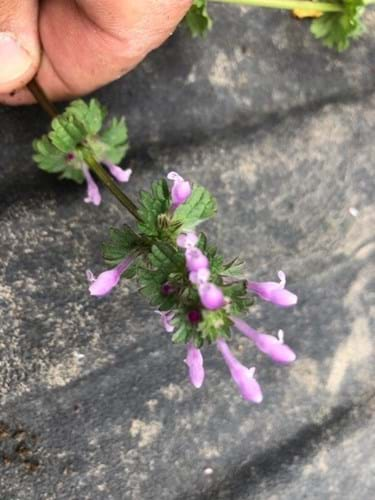
Henbit
Weeds in the mustard family (Brassica) are another frequent occupant of our fields in early spring. One of the most prevalent tends to be wintercress (photo below). We may also see cressleaf groundsel which also has yellow flowers at this time of year.
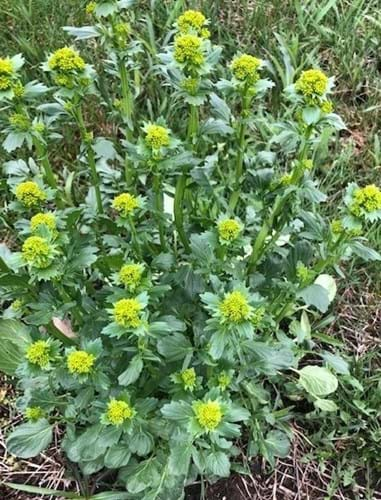
Wintercress
Chickweed is probably the worst culprit interfering with seedbed preparation. This is especially true when it comes to light tillage just prior to planting. Control of this weed is key to getting good seed-to-soil contact and stand establishment.
Poison hemlock is a biennial and starts early in the spring. This weed is not as much an issue in row crops. For the hay and livestock producers, this one is nasty and spreading fast. It resembles Queen Anne’s lace but doesn’t have hairs on the stems and it also greens up in early spring. Queen Anne’s lace will show up later in the season. It is poisonous to livestock, so control is important along field edges, feedlots and hay fields where it prefers to grow.
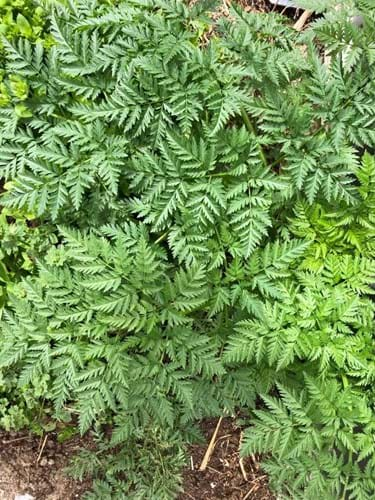
Poison hemlock
Field pennycress is another common spring weed that tends to have white flowers. A winter annual similar to many in this write-up. It is in the Mustard family of weeds. Shepherds’ purse can be confused with this plant. One differentiating trait of field pennycress is the more heart-shaped seed pod.
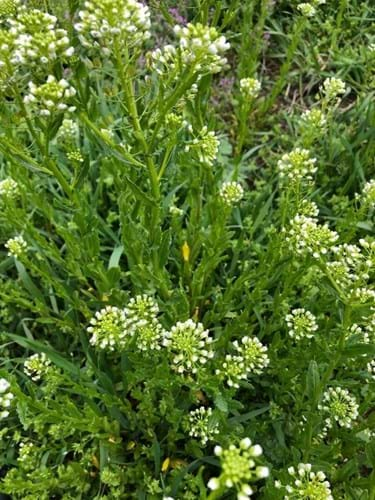
Field Pennycress
Marestail is another very common weed pest that plagues us especially in our low to no-till fields. Its ultra-small seeds won’t handle much tillage. We will be seeing the rosette stage (pictured below) this time of year.
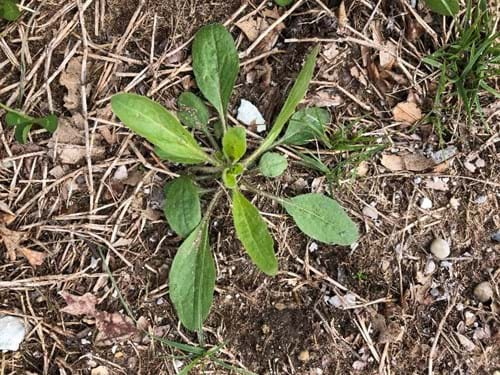
Marestail rosette
And what would a spring weed burndown article be without mentioning dandelion. Need we say more.
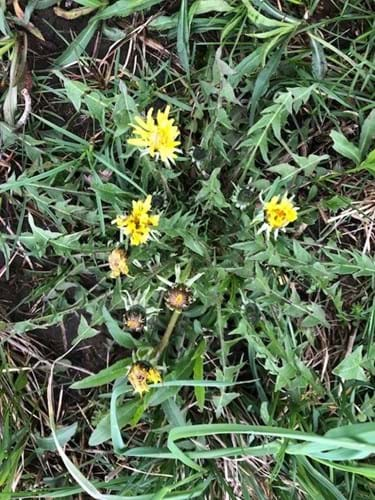
As is true in the world of agriculture, there are plenty more weeds we could mention. Those mentioned above may be the species we see the most. For control suggestions continue to read this week’s newsletter and or consult your local Dairyland Seed and/or Corteva Agriscience™ crop protection professional.
For further reference catch some of these resources:
https://cropwatch.unl.edu/2020-CW-News/documents/ID-of-Winter-Weeds-EC-304.pdf
https://farmdoc.illinois.edu/field-crop-production/weeds/a-review-of-early-season-weeds.html
EARLY SEASON HERBICIDE BASICS
Availability and supply of herbicide has been a common topic this winter/spring. As we look to begin herbicide applications, it is crucial that we look to maximize herbicide efficacy. Starting with a clean field will help to optimize season-long weed control.
Maximizing Efficacy
- Mixing order: Proper mixing order ensures that products are correctly put into solution so that there is no antagonism or “tie up”. Adding products to the tank in the correct order also helps to eliminate the chance of mixing issues such as solids forming in the tank. When in doubt, jar test.
- Use water conditioners and adjuvants. In short, these additives help the herbicides to work as they should. Adjuvant herbicides aid post-emergence herbicides by entering the plant tissue which results in a better kill of target weeds.
- Nozzles and application rates: The use of proper nozzles and application rates improves coverage on emerged weeds as well as proper distribution of residual herbicide.
Burndown Considerations
- Spring tillage is an option for early weed control and will be used in many areas due to little tillage being completed last fall. An important piece to consider is that weeds that survive tillage, can be more difficult to control with herbicide once tillage is complete.
- Average daytime temps of around 55o and nighttime temps of 40 o + are ideal for burndown applications. If temperatures are on the cooler end of this range, control is best achieved with an approved application of synthetic auxin herbicides (Enlist One® herbicide, 2,4-D, etc.).
- Target weeds of 3 to 4 inches: This is the common weed height for any herbicide application. Plant height is crucial for winter annual control especially if they over-wintered.
- One shot of glyphosate? Use it in burndown if weed pressure is heavy. Starting clean and staying clean is easier than trying to play catch up in post applications.
- Residual application: Lighten the load for post-application products. The use of products with multiple modes of action at burndown/preplant will help to keep fields clean. The use of approved residual products later in the season can help maintain season-long weed control.
If you have any questions about specific early herbicide applications for your area, contact your Dairyland Seed Regional Agronomist or DSM for more information.
 |
 |
 |
 |
 |
| Brian Weller Western Region 507.456.3034 |
Dan Ritter Central Region 219.863.0583 |
Branden Furseth Northern Region 608.513.4265 |
Mark Gibson Eastern Region 260.330.8968 |
Amanda Goffnett Eastern Region 989.400.3793 |
